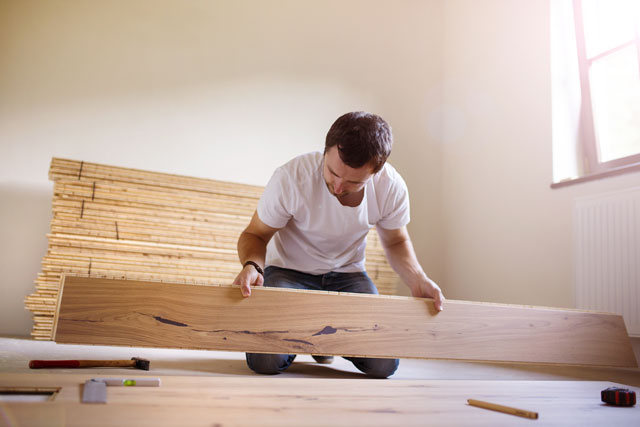 Acclimation is the process that allows wood flooring to match its installation environment. It is also known as conditioning and it is a vital part of the installation process.
Acclimation is the process that allows wood flooring to match its installation environment. It is also known as conditioning and it is a vital part of the installation process.
Commonly, most wood floorings have moisture content (MC) between 4-13%. This matches the average equilibrium moisture content (EMC) of most homes in temperate regions (with HVAC operable). The region of the home determines what the range of acceptable MC will be. You should review the NWFA MC map to determine the acceptable range for your area. Acclimation should be short and simple if the installer exposes wood flooring to interior EMCs in the 6-9 % range.
Why is Acclimation Important?
Wood flooring tends to absorb moisture from its environment. This makes it detrimental to the acclimation process if you store the wood in an uncontrolled environment. Places such as a basement, garages, or an unconditioned warehouse can cause the wood to take up more moisture than it needs. This, in turn, will change the dimensions of the product. So, it is vital that you properly acclimate any wood that you have stored in a cool or damp environment.
How to Acclimate Wood
Fortunately, most manufacturers provide instructions on how to successfully acclimate their products. There may be small discrepancies between different guidelines, but most of those instructions say the same thing. And if the manufacturer does not provide instructions, always use the NWFA Guidelines.
There are certain tools the NWFA Installation Guidelines require you to have on hand. Either a handheld resistance-type meter (prong meter) or capacitance-type meter (pinless meter) are necessary for the job. These tools help determine the MC of wood flooring and wood-based subfloors. Also, the average wood subfloor MC should be no greater than 4% from the average strip flooring MC (2% for plank flooring) at the time of installation. With these in mind, it should be easy to install your wood flooring.
When Acclimation is Not So Simple
But what happens if the wood flooring has a high MC? You should set aside extra time for the acclimation process. Remember that if the MC in the wood changes, the shape of the wood changes also. This could affect the timeline of the installation process. If this is the case for your wood flooring, plan and schedule accordingly.
To quicken the process, there are many things you can do to reduce the MC of the wood flooring. One of these options is to remove the material from its packaging. Then place the material on stickers. Stickers are anything (scrap pieces of wood or thick pieces of cardboard) able to create a ½”- plus gaps between the wood boards while it is acclimating. Lay the stickers out on the subfloor. It is important to place the stickers perpendicular to the length of the flooring at 24” intervals. This ensures that it provides enough support for the wood flooring.
Once you fit the stickers on to your floor space, stack the first layer of flooring. Then place the second layer of stickers on top and repeat this pattern. But, do not stack too many layers of flooring as any heaviness could leave an indent on the bottom layers. This depends entirely on the hardness of both your stickers and the flooring. When acclimating, it is good to know the density of your wood of choice. Less dense woods (cherry or walnut) indent easier compared to denser woods (oak or hickory).
It is crucial to align the stickers. This will ensure even support of the flooring during acclimation. More importantly, you need to schedule ample time to allow the wood MC to match the MC of its environment. The more time you have, the more successful your installation process will be.
The Bottom Line
There are many other methods of acclimation. But the essence of acclimation is allowing the wood to have enough exposure time to its environment. Unfortunately, the acclimation process can be done improperly or overlooked altogether. This is usually attributed to time constraints on the job site. While it can be time-consuming, acclimation ensures a successful installation job. So if you do not want any complaints from unsatisfied customers, acclimate your wood!
How to Keep an Eye on Your Floor
Your floors need regular attention even after a successful acclimation and installation job. After all, these floors are your investment. So, it is vital to have them monitored for any wear and tear.
The Fidbox Electronic Monitoring System determines the consistency of the environmental conditions of where you install your wood floor. This system is installed under your floors and communicates via an app on a smartphone. The Fidbox monitors the moisture level of the floor and alerts you if anything is wrong.
This innovative device takes a professional, proactive approach to tell you when your floors need attention. In simple terms, it alerts you before any irreversible damage takes place. The Fidbox Electronic Monitoring System works with every type of wood. It also works well with all types of subfloors. So now, you can rest assured knowing that your floors are kept in mint condition!